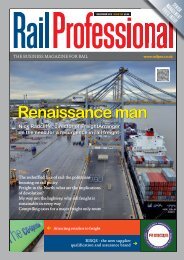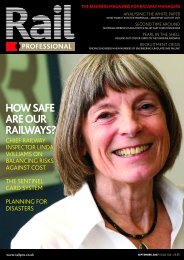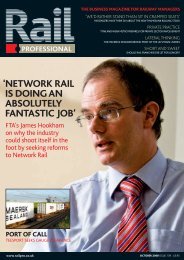View as PDF - Rail Professional
View as PDF - Rail Professional
View as PDF - Rail Professional
Create successful ePaper yourself
Turn your PDF publications into a flip-book with our unique Google optimized e-Paper software.
Rolling stock<br />
Russ Hargrave says the Intercity Express Programme is a prime example of the benefits<br />
of ‘designing in’ maintainability into rolling stock, right from the start<br />
The first Super Express Trains for the<br />
Intercity Express Programme (IEP)<br />
will begin testing in the UK in early<br />
2015, two years before entering full<br />
p<strong>as</strong>senger service. Maintainability h<strong>as</strong> been<br />
tackled <strong>as</strong> a key requirement of the train<br />
design from the start and the through-life<br />
maintenance philosophy h<strong>as</strong> been carefully<br />
considered.<br />
The IEP includes a 27.5-year<br />
maintenance contract, making whole-life<br />
maintainability a key requirement of the<br />
train design. To ensure this requirement is<br />
satisfied, the maintenance team is closely<br />
integrated with both the design and<br />
procurement teams. The aim is to 'design-in'<br />
maintainability from the very earliest stages<br />
of any train supply contract, and this starts<br />
with a process that ensures all Requests<br />
for Quotation to component suppliers are<br />
reviewed, commented on and adjusted by<br />
members of the maintenance team.<br />
The maintainability requirements of<br />
the IEP units therefore take into account<br />
operational needs, reliability targets<br />
and project costs, and were specified at<br />
project inception. All suppliers have been<br />
requested to provide a complete Life Cycle<br />
Cost (LCC) model in a standard Hitachi<br />
format, and within this model, suppliers<br />
must include a full list of routine, heavy<br />
and likely unplanned maintenance t<strong>as</strong>ks<br />
with all <strong>as</strong>sociated costs, labour and spares<br />
requirements.<br />
The HRE (Hitachi <strong>Rail</strong> Europe) LCC<br />
model feeds into a formal and objective<br />
supplier selection process according to the<br />
particular requirements of the train design<br />
in question. This process allows the most<br />
appropriate equipment for the specific train<br />
operation to be selected, and ensures that<br />
not only the initial build, but the wholelife<br />
support requirements and <strong>as</strong>sociated<br />
costs are considered in the procurement<br />
process. Maintenance staff are also involved<br />
in supplier visits from the beginning of<br />
product design and attend prototyping<br />
and first article inspection meetings to<br />
ensure compliance with the maintainability<br />
requirements.<br />
To ensure maintainability really is<br />
'designed in' throughout the design process,<br />
dedicated maintainability engineers who<br />
work for the maintenance department<br />
review all elements of the train design with<br />
the design engineers. During critical periods<br />
these specialists are embedded within the<br />
design team to ensure that issues can be<br />
dealt with promptly, and that where changes<br />
are required, these can quickly be made<br />
during the pre-production stage to avoid<br />
costly re-design in future. In the c<strong>as</strong>e of<br />
Hitachi’s existing Cl<strong>as</strong>s 395, formal reviews<br />
took place on a monthly b<strong>as</strong>is throughout<br />
the design process and the same established<br />
principles are being deployed on IEP.<br />
As the first IEP test trains are built,<br />
maintenance t<strong>as</strong>k trial runs will be plannedin<br />
to the build programme and undertaken<br />
with the involvement of maintenance staff<br />
who approved the design. For Cl<strong>as</strong>s 395 this<br />
work w<strong>as</strong> carried out at Hitachi’s factory<br />
in Japan before the first units were shipped<br />
to the UK, which served two purposes: it<br />
allowed maintainability design changes<br />
to be proposed and very quickly actioned<br />
with the Japanese design engineers, and it<br />
also acted <strong>as</strong> a test bed for the maintenance<br />
documentation and <strong>as</strong>sociated processes.<br />
These could then be modified and rewritten<br />
to provide a functional manual<br />
before the trains arrived at the depot.<br />
Once there, modifications to improve<br />
maintainability continued to be carried out<br />
<strong>as</strong> suitable opportunities were identified.<br />
With Cl<strong>as</strong>s 395 in full service we are now<br />
at a stage where continuous improvement<br />
principles and <strong>as</strong>sociated modifications are<br />
being applied on a routine b<strong>as</strong>is to ensure<br />
performance and reliability targets are met.<br />
For IEP the same, proven approach<br />
to developing, demonstrating and<br />
documenting our maintenance processes<br />
will be adopted, but will also incorporate<br />
the lessons learned from other projects,<br />
and in particular Cl<strong>as</strong>s 395. In addition, it<br />
is important to highlight that throughout<br />
the design, test and delivery process, the<br />
whole project team h<strong>as</strong> a remit to ensure<br />
maintenance and support requirements<br />
are continually reviewed and optimised to<br />
ensure we deliver against our contractual<br />
commitments.<br />
Optimising the maintenance regime –<br />
mileage-b<strong>as</strong>ed, time-b<strong>as</strong>ed maintenance<br />
and condition monitoring<br />
Historically, the UK h<strong>as</strong> seen a mixture of<br />
July/August 2013 Page 59
















